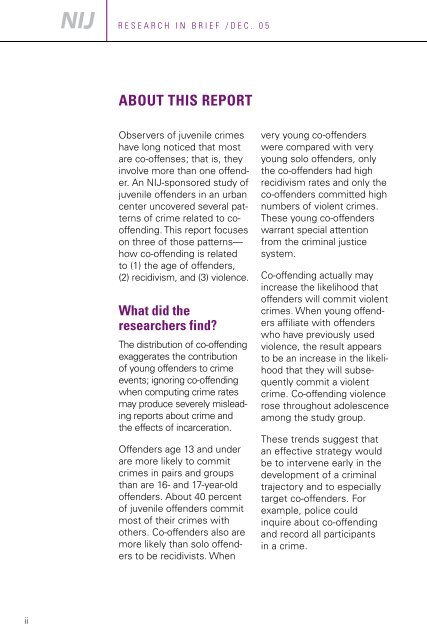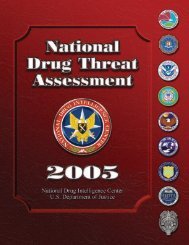Co-Offending and Patterns of Juvenile Crime - justice studies
Co-Offending and Patterns of Juvenile Crime - justice studies
Co-Offending and Patterns of Juvenile Crime - justice studies
Create successful ePaper yourself
Turn your PDF publications into a flip-book with our unique Google optimized e-Paper software.
R E S E A R C H I N B R I E F / D E C . 0 5<br />
ABOUT THIS REPORT<br />
Observers <strong>of</strong> juvenile crimes<br />
have long noticed that most<br />
are co-<strong>of</strong>fenses; that is, they<br />
involve more than one <strong>of</strong>fender.<br />
An NIJ-sponsored study <strong>of</strong><br />
juvenile <strong>of</strong>fenders in an urban<br />
center uncovered several patterns<br />
<strong>of</strong> crime related to co<strong>of</strong>fending.<br />
This report focuses<br />
on three <strong>of</strong> those patterns—<br />
how co-<strong>of</strong>fending is related<br />
to (1) the age <strong>of</strong> <strong>of</strong>fenders,<br />
(2) recidivism, <strong>and</strong> (3) violence.<br />
What did the<br />
researchers find?<br />
The distribution <strong>of</strong> co-<strong>of</strong>fending<br />
exaggerates the contribution<br />
<strong>of</strong> young <strong>of</strong>fenders to crime<br />
events; ignoring co-<strong>of</strong>fending<br />
when computing crime rates<br />
may produce severely misleading<br />
reports about crime <strong>and</strong><br />
the effects <strong>of</strong> incarceration.<br />
Offenders age 13 <strong>and</strong> under<br />
are more likely to commit<br />
crimes in pairs <strong>and</strong> groups<br />
than are 16- <strong>and</strong> 17-year-old<br />
<strong>of</strong>fenders. About 40 percent<br />
<strong>of</strong> juvenile <strong>of</strong>fenders commit<br />
most <strong>of</strong> their crimes with<br />
others. <strong>Co</strong>-<strong>of</strong>fenders also are<br />
more likely than solo <strong>of</strong>fenders<br />
to be recidivists. When<br />
very young co-<strong>of</strong>fenders<br />
were compared with very<br />
young solo <strong>of</strong>fenders, only<br />
the co-<strong>of</strong>fenders had high<br />
recidivism rates <strong>and</strong> only the<br />
co-<strong>of</strong>fenders committed high<br />
numbers <strong>of</strong> violent crimes.<br />
These young co-<strong>of</strong>fenders<br />
warrant special attention<br />
from the criminal <strong>justice</strong><br />
system.<br />
<strong>Co</strong>-<strong>of</strong>fending actually may<br />
increase the likelihood that<br />
<strong>of</strong>fenders will commit violent<br />
crimes. When young <strong>of</strong>fenders<br />
affiliate with <strong>of</strong>fenders<br />
who have previously used<br />
violence, the result appears<br />
to be an increase in the likelihood<br />
that they will subsequently<br />
commit a violent<br />
crime. <strong>Co</strong>-<strong>of</strong>fending violence<br />
rose throughout adolescence<br />
among the study group.<br />
These trends suggest that<br />
an effective strategy would<br />
be to intervene early in the<br />
development <strong>of</strong> a criminal<br />
trajectory <strong>and</strong> to especially<br />
target co-<strong>of</strong>fenders. For<br />
example, police could<br />
inquire about co-<strong>of</strong>fending<br />
<strong>and</strong> record all participants<br />
in a crime.<br />
ii





